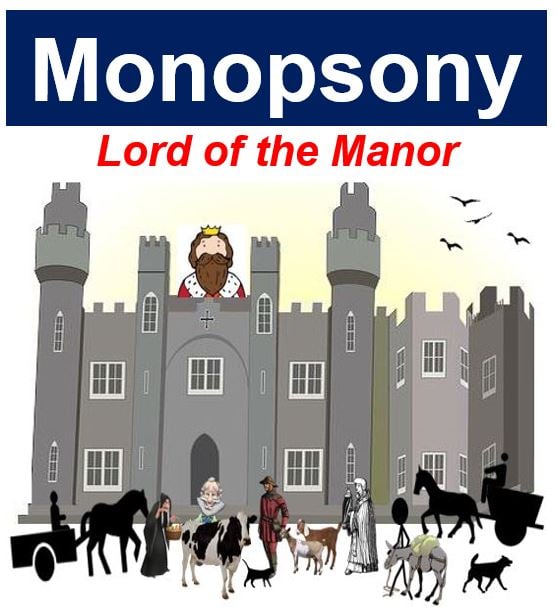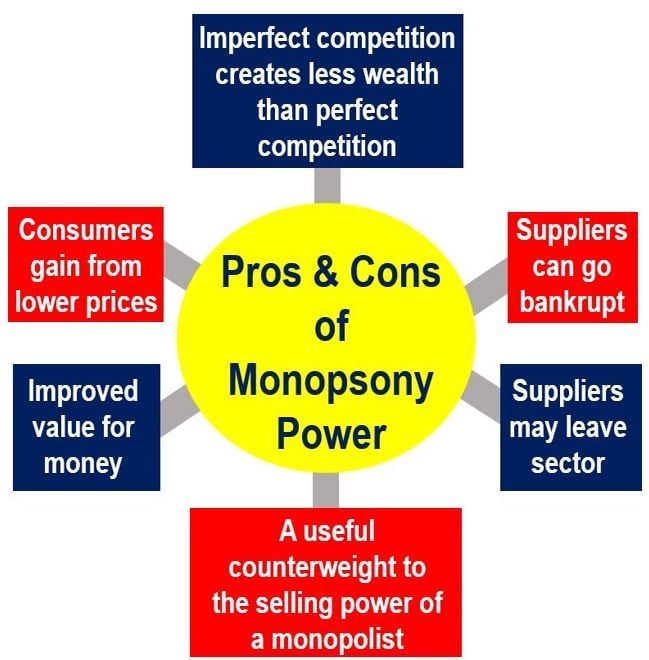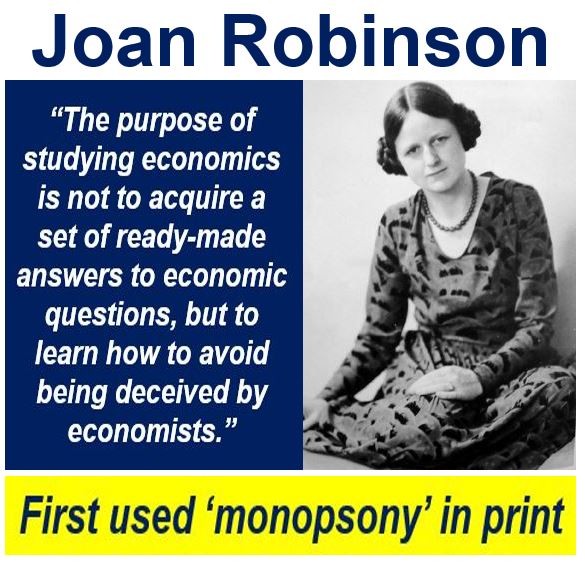A Monopsony is either a market where only one buyer exists or where a single buyer dominates the market. We often refer to it as a buyer’s monopoly. The term refers to just the number of buyers. In this type of market, there may be many suppliers.
The monopsonist can call the shots regarding prices and product descriptions. They can also dictate terms regarding delivery dates.
Some people say that monopsony is a back-to-front monopoly. A monopoly is a market where there is just one supplier.
Monopsony may also refer to the job market, i.e., one where a single entity is a town’s largest employer.

The term ‘monopsony’ appeared publicly in the English language in 1933. Joan Robinson used it in her influential book The Economics of Imperfect Competition.
Joan Robinson (1903-1983) was a British economist, famous for her contributions to economic theory. She was one of the 20th century’s greatest economists. Ms. Robinson credited Bertrand Hallward (1901-2003), a Classics don at Peterhouse, Cambridge, for coining the term.
Monopsony in defense industry
In the advanced economies, such as the United States, the defense industry is a monopsony. The American and British the Department of Defense and Ministry of *Defence respectively represent the vast majority of all domestic sales of the country’s home-based defense companies.
* In British/Canadian/Australian/Irish English, the spelling is ‘Defence,’ while in American English it is ‘Defense.’
Bethesda-based Lockheed Martin, America’s largest defense company, employs more than 120,000 workers. It would be just a tiny fraction of its current size had it not been for the US Department of Defense.
US government contracts represent eighty-five percent of Lockheed Martin’s yearly sales. Those from foreign governments account for thirteen percent. Commercial contracts only make up 2% of the company’s total sales.
We often use the term B2G when referring to government contracts. B2G stands for business-to–government.

A monopsony is usually a less than ideal situation, which sometimes requires legislation to prevent abuse. However, monopsonistic-type behaviors by, for example, supermarkets, result in cheaper prices for consumers. Subsequently, many people see it as a benefit.
Regulatory bodies often scrutinize monopsonistic markets to ensure fair trade practices and prevent suppliers from being unfairly disadvantaged
While monopsonies can negatively impact suppliers through lower prices, they can sometimes spur innovation as suppliers strive to reduce costs and improve product quality.
Monopsony battles for business
In a monopsony, suppliers frequently engage in price wars to try to gain business from the single buyer. Their behaviors drive down prices.
Companies that battle each other in a one-buyer market commonly get caught in a ‘race to the bottom,’ during which they lose any power they used to have over supply and demand. They end up totally at the mercy of the monopsonist.
Some technology companies have been accused of monopsonistic-type behaviors in the labor market. For example, the market for engineers may consist of just a few giant tech companies which collude and choose not to compete with each other regarding wages, perks, and other workplace conditions.
Oracle and Cisco have sometimes been accused in the media of discreetly agreeing not to compete on wages.
By effectively creating a wage cartel, pay is suppressed so that tech giants can realize lower operating costs and greater profits. In such cases, the collusion by a group of large companies is, in effect, a monopsony.

Examples of monopsony
Monopsonies or monopsonistic type behaviors exist all over the world.
Electricity
In many countries, electricity generators can negotiate lower prices with suppliers of coal and/or gas.
Supermarket chains
Giant supermarkets often behave like monopsonists, even though they are not the only buyer. They have virtually absolute power when purchasing goods from milk producers, farmers, wine growers and other suppliers.
A country’s largest car-rental firm that is negotiating with a supplier of cars may exhibit monopsonistic-type behaviors. It is probably by far the supplier’s largest client and is in a position to dictate terms.
UK health care
In the United Kingdom, the National Health Service represents more than 90% of the purchases of all drugs, medical devices and other health-related products and services.
Amazon.com is emerging as the Goliath of the retail sector. It currently gets a better price than any other bookseller and most sellers of other goods.
Monopsony is one of the features of Imperfect Competition. Imperfection competition exists in a competitive market where some of its features or sectors are not completely competitive. There may be too few sellers or buyers.
Types of markets
There are many different types of markets, apart from “monopsony.” Let’s have a look at some of them, their meanings, and how we can use them in a sentence:
Monopoly
A market structure characterized by a single seller, selling a unique product in the market. In a monopoly market, the seller faces no competition, as he is the sole seller of goods with no close substitute.
Example: “The local utility company is an example of a monopoly, as it is the only provider of electricity and gas in the region.”
Duopoly
A market scenario where two companies own all or nearly all of the market for a given product or service.
Example: “The commercial aircraft market is often cited as a duopoly because Boeing and Airbus are the two major suppliers.”
Oligopoly
A market structure in which a small number of firms has the large majority of market share. An oligopoly is similar to a monopoly, except that rather than one firm, two or more firms dominate the market.
Example: “The smartphone market is an oligopoly with major players like Apple and Samsung dominating the sales.”
Perfect Competition
Definition: A market structure characterized by a complete absence of rivalry among the individual firms. In a perfectly competitive market, there are an infinite number of producers and consumers, and no barriers to entry or exit.
Example: “Local farmers markets are great examples of perfect competition, with numerous sellers offering similar products.”
Monopolistic Competition
A type of imperfect competition such that many producers sell products that are differentiated from one another and hence are not perfect substitutes.
Example: “The fast-food industry is a form of monopolistic competition with various firms offering different styles of food.”
Contestable Market
A market where companies can enter and exit freely, and the threat of potential entry of new firms exists, which keeps the prices in check.
Example: “Online retail is a highly contestable market, as new web-based stores can set up and compete with relative ease.”
Bilateral Monopoly
A market with only a single supplier and a single buyer.
Example: “In a bilateral monopoly for custom machine parts, the sole manufacturer negotiates directly with a single buyer who needs their specialized components.”
The suffix ‘opoly’ – n economic terms, the suffix (word ending) “-opoly” denotes the number of sellers in a market and the distribution of market power. For example, the prefix “mono” in “monopoly” means a single or one seller, while “duo” in “duopoly” means two sellers.
Video explanation
